As an Amazon Associate, I earn from qualifying purchases with no additional costs for you.
Any true wine lover deserves a space in their own home built with quality materials and styled for storing and displaying a stunning collection of great wines. Lately, you’ve been working on a personalized design to create your ideal space. But while you know plenty about the wood used to cask your favorite vintages, you may not know which wood is best for your home wine cellar.
What are the best woods and materials for a wine cellar? While the type of wood you use for your cellar is paramount to protecting from unwanted moisture or rot, wood is not the only thing to consider when building your wine cellar. You will also need good insulation, moisture barriers, flooring, and well-sealed doors.
There are so many variables when it comes to building out your wine cellar, so first, we are going to look at examples of the best woods to use in a wine cellar build, and what makes each wood optimal.
We will briefly touch upon a wood-free wine cellar, but from there, the discussion will move toward the additional materials you will need to safely store and display your wine collection.

TIP: If you want to check out the best refrigerator for wine storage, I recommend trying out the Avation (18 bottles) compressor refrigerator with Wi-fi smart app control cooling system. You can find this refrigerator by clicking here (Amazon link).
Comparing Woods for Building a Wine Cellar
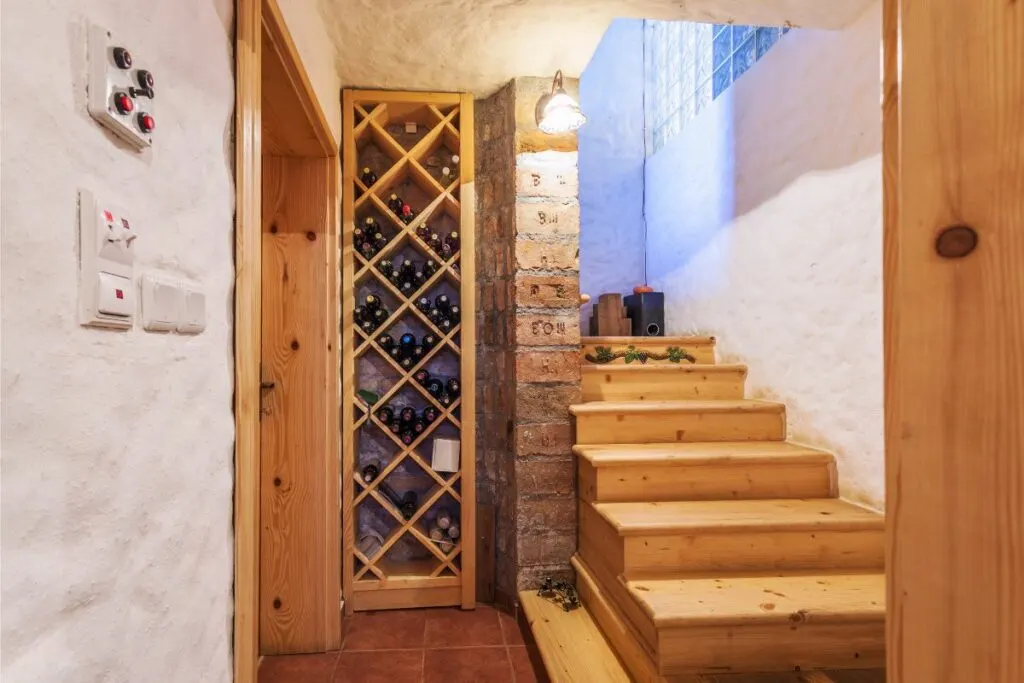
Wood provides any room with a rich atmosphere. It feels sturdy, provides natural warmth, and occasionally offers up a sweet aroma. When used in the wine cellar, the wood you choose will set your color palette, certainly.
But it will also need to serve the wine by maintaining consistency in the climate of the room, as well as resisting mold. Below are what we consider notable options for wine cellar wood material in order from best to worst.
| Type of Wood | Benefits | Negatives |
|---|---|---|
| Redwood | – Sustainable – Natural tolerance for humidity – Beautiful natural color variation | – Does not hold stains well – Not as hard as mahogany |
| Oak | – Wide variety in natural color – A fragrance that goes well with wine – More affordable | – Heavy |
| Mahogany | – Durable – Beautiful – Holds a dark stain while maintaining grain | – Not sustainable – Heavy – Expensive |
| Walnut | – Natural patina with age – Stunning color variation – Polishes very smoothly | – Expensive – Rare, slow-growing wood |
| Pine | – Cheap – Lightweight – Simple, rustic look and color | – Soft – Low shock resistance – Bends and dimples easily – May mold over time |
| Cedar | – Deep red hue – Cheap – Repels insects | – Not structurally sturdy – Fragrance may ruin the wine – Fragrance may trigger asthma or skin allergies |
If you are curious about what the average cost is for a wine cellar installation and build, check out this detailed and comprehensive article where I provide real-life examples. To learn all the factors and components that make for a great wine cellar, check out this article I wrote that goes into amazing detail on the topic.
TIP: This article explains the costs to repair a wine refrigerator and the most common problems. Read this informative article to find out all about popular storage myths!
Redwood
A lot of sources point to redwood as the ultimate in wine cellar building material. This is a naturally beautiful wood with a color variation from pale pink to medium brown. Without treatment, it ages with a lovely patina.
Forests of redwoods grow along the west coast of the United States, where the wood is adapted to humidity. Additionally, the practice of redwood harvesting in the U.S. is highly managed for sustainable practice, making it an earth-friendly choice.
Its natural oils and porosity leave it impervious to moisture absorption and rot. It is dense and not prone to warping. One negative is that it does not stain well.
As we mentioned, it has grown to repel moisture, and unfortunately, that includes stain. Another negative is that it is softer than mahogany, which is an extremely durable hardwood.
Oak
Oak and wine already seem to go hand in hand. Your favorite chardonnay, for example, was casked for a little over a year in an oak barrel.
Also, similar to wine, it comes in red and white varieties, so you have flexibility with your color palette. This may seem like an obvious choice.
However, putting your sommelier hat aside, let’s discuss the benefits of oak from a carpentry perspective. Oak is a sturdy hardwood with straight grain and natural character.
It is capable of holding the weight with great shock resistance and imperviousness to bowing. Additionally, oak is rot resistant. It also responds well to stains which is great for customization.
The main downside of oak is its weight. If you are going to be doing your heavy lifting, or if you’re highly sympathetic toward your building team, you may consider the weight.
Mahogany
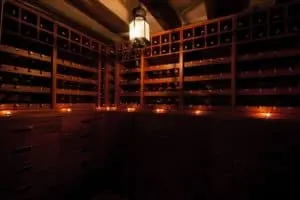
When you think of luxury, you think of mahogany. It’s famously used for quality furniture and high-end cabinetry and interior finishes. It has a lovely hue that ranges from pale to medium pink, and a very straight and even grain.
While gorgeous in its own right, it also takes a stain well. It is one of the few kinds of wood that can take an extremely dark stain and maintain a grain.
In terms of woodworking quality, mahogany is also rot-resistant and sturdy. Mahogany machines very easily for lovely accurate cuts. It is dense and very hard, so it won’t warp or shrink with temperature variation (although, truly, your cellar should be climate-controlled to prevent this anyway).
However, like the oak, mahogany is going to be extremely heavy. Another negative to take into consideration is that it is not particularly friendly to the earth.
Most mahogany will come from Southeast Asia, Brazil, or Mexico, where deforestation is a growing issue. The environmental impact of using mahogany may play into your decision.
Walnut
Walnut is a carpenter’s favorite wood. It is naturally a dark wood with a gorgeous color variation from a creamy beige to chocolatey brown. The grain is tight, and it polishes easily to buttery smoothness.
As it ages without stain, it grows more and more lustrous making it extremely elegant in its rite. This hardwood is widely used for flooring and cabinetry because it’s reliable, doesn’t warp, ages well, and is resistant to rot and chipping.
We love wine cellars that feature great walnut finishes because of how nice this wood is to work with. Like all the woods on this list, walnut is heavy and dense.
So that aside, the main thing we might consider as a negative of walnut is the cost. It tends to be more expensive because the trees are rarer, smaller, and grow slower than other North American hardwoods.
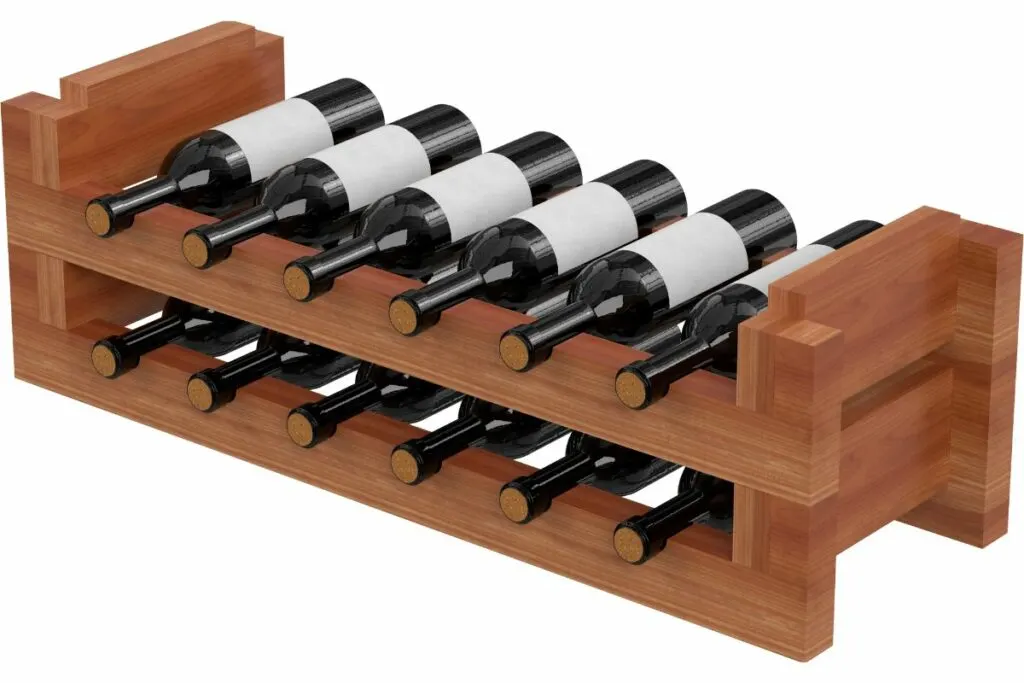
Pine
As you peruse the wood options, you’ll see pine. This wood is naturally a soft vanilla color, with characteristic knots and streaks. It looks interesting and rustic. You’ll also notice that it is very cheap. This is because pine trees grow quickly and in abundance throughout the United States.
Pine is frequently listed as an option on most wine cellar builders’ sites. However, it is on the list of options to make a cellar affordable and accessible. That does not make it an optimal choice.
The wood has a very open grain which means it absorbs moisture, bows, and breaks very easily. It’s soft and not strong enough to hold a lot of weight. We would not use pine for a wine cellar.
Cedar
All this talk of wood types and you’re probably wondering, “Can I use cedar for a wine cellar?” Yes, of course, you can use cedar if that is what you want. We’ve all heard about how cedar is great for absorbing moisture and repelling insects. It even smells nice.
When you look at the cedar boards in the store, you’ll notice they have a gorgeous red tint, and it’s easy to imagine how beautiful a room of that would be.
So, from a woodworking perspective, here’s why maybe cedar isn’t the greatest material to build the whole wine cellar: it’s not the most structurally stable material. It’s great for linings and sidings, but it is not great for something that will be holding your valuable collection of wines.
Another point to note is that cedar is highly aromatic. This is why a lot of people love it in closets. However, the jury is still out on whether or not that strong aroma can affect the flavor of your wines.
At the humidity levels necessary to protect the corks in your wine, you might expect a water-soluble, airborne fragrance to potentially absorb into the cork as well.
Some experts say this is inaccurate, though, so it is up to you. However, aside from the potential of ruining the flavor of your wines, please note that the fragrance of cedar can trigger issues in people with asthma or very sensitive skin.
TIP: Can you decant all wines, or should all wines be kept in the dark? Find out here and here.
Choosing Insulation for a Wine Cellar
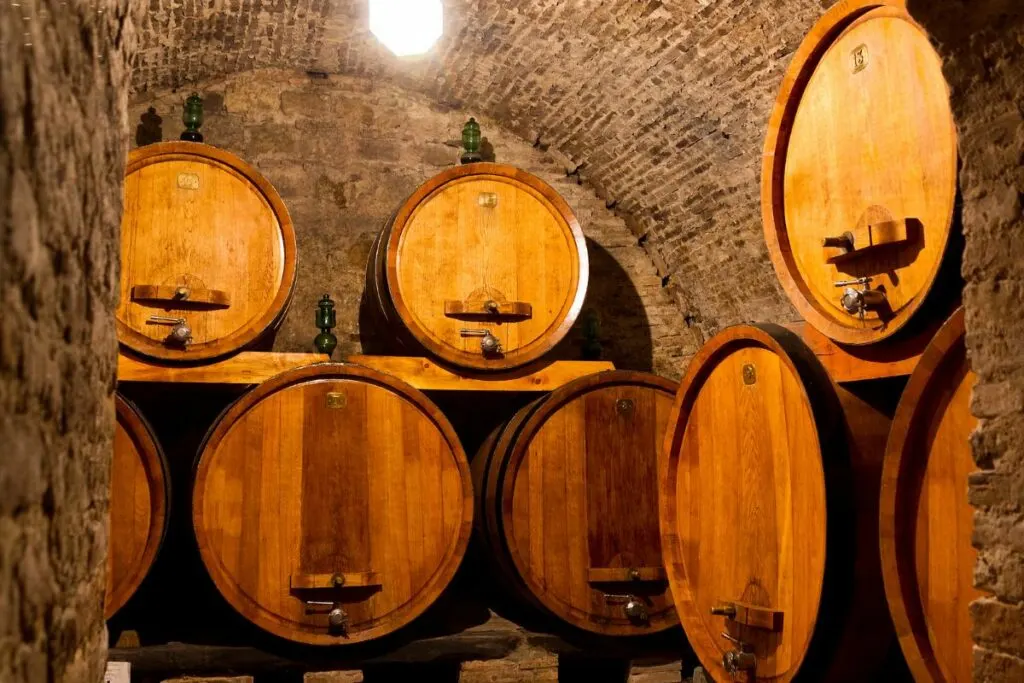
The wood your pick for your wine cellar will be the star of the show, but behind the scenes, you’ll need a great climate control system in place. That starts with the insulation. This is a quick and easy choice to make, but that doesn’t make it less important.
Temperature fluctuations cause the cork to expand and contract, which means that at the very least, your wine flavor is going to be dramatically altered, but at worst, you could have a whole lot of bottles leaking everywhere. That makes insulation extremely valuable for your cellar.
Since a wine cellar is an investment to protect a whole collection of other investments, spend the money on good insulation. Spray foam is going to do the best job of keeping the temperature consistent, which is the most important aspect of a good wine cellar.
So, choose a medium-density spray foam insulation, like closed-cell. It works as a vapor barrier, air barrier, and thermal insulator. This is going to save you a little work since you’ll need a separate product to provide your vapor barrier from your insulation.
That said if you choose to go with a fiberglass batting insulation, opt for a 6-mil polyethylene sheeting vapor barrier in addition to the insulation that rates between R12 and R19 or R30 for exterior walls.
The Best Choices for Flooring in Your Wine Cellar
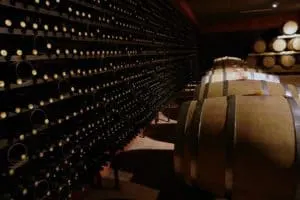
The flooring you put down in your cellar should be incredibly sturdy and able to bear a lot of weight, especially if you have a large wine collection.
Since you’re most likely building your wine cellar in the basement, you’ll be starting with a concrete slab floor. This will promote a cool temperature, but it means you’ll need to lay down a moisture barrier before you start proper flooring.
Sealed hardwood. To achieve the look of wood flooring, you’ll want sealed hardwood. While you can go with a nice straightforward pattern, don’t rule out creating an intricate pattern.
Since you’ll be “tiling” the floor with the hardwood to establish a firmer foundation, you have more options than with channel cut wood planks. Those kinds of flooring float over the floor and will buckle under the weight of your wine.
Ceramic tile or stone flooring. This adheres directly to the subfloor creating a sturdier base that also looks nice. Some may even like the look of brick tiles for an industrial-style finish.
Note that with these types of flooring, you’ll need to consider the height of your door and the threshold to get a strong seal on your cellar door.
Cork. For a surprising twist on flooring, you could try cork. Like oak for the cellar build, cork seems like an obvious choice to pair with wine. It’s a natural material that is also durable and sturdy.
As a bonus, it’s a sustainable material because it’s made from a renewable resource. If you needed more reason to try cork flooring, it’s cushiony meaning it’s more forgiving on your joints and the occasional dropped bottle.
TIP: Are wine stoppers and aerators a requirement for pouring and storing wine? Find out in this article and this one!
TIP: Are you interested in buying a wine stopper? We’ve personally tried and recommend buying one of these wine stoppers (Amazon links):
- The Original Vacu Vin Wine Saver: Our top choice. Very easy-to-use wine stopper/saver. You can enjoy a glass of fresh wine whenever you want without worrying about wasting any.
- EZBASICS Wine Saver: Great alternative to Original Vacu Vin Saver. This wine stopper keeps the flavor of wine for up to one week.
- Champagne Stopper by MiTBA: Wine stoppers for sparkling wines are different. This wine stopper seals your bottle and increases the pressure so your beverage’s bubbles won’t go to waste.
The Importance of Air Conditioning and Humidity
We’ve been talking about it this whole time, but here are the specifications you’ll need to know for maintaining a climate in your wine cellar.
Wine should optimally be stored in a temperature range between 50ºF to 60ºF at a humidity level of approximately 65% humidity. For this reason, you need to first make sure that your vapor barrier and insulation are well installed.
But additionally, you need a good cooling system that will provide this room with its ideal conditions. Because there is such a variety of options on the market, shop around, and discuss your options with your contractor.
TIP: Controlling the humidity in a wine refrigerator is important – this article explains why. Read about the best small wine coolers in this guide.
TIP: Most wines go bad once you pop the cork within a day or so. But a Coravin Wine Preservation system (available for a great price on Amazon) can extend the life of your opened wine for weeks or even months. It is awesome. You should check it out to see if it fits your lifestyle.
Why Use an Exterior Door on the Cellar
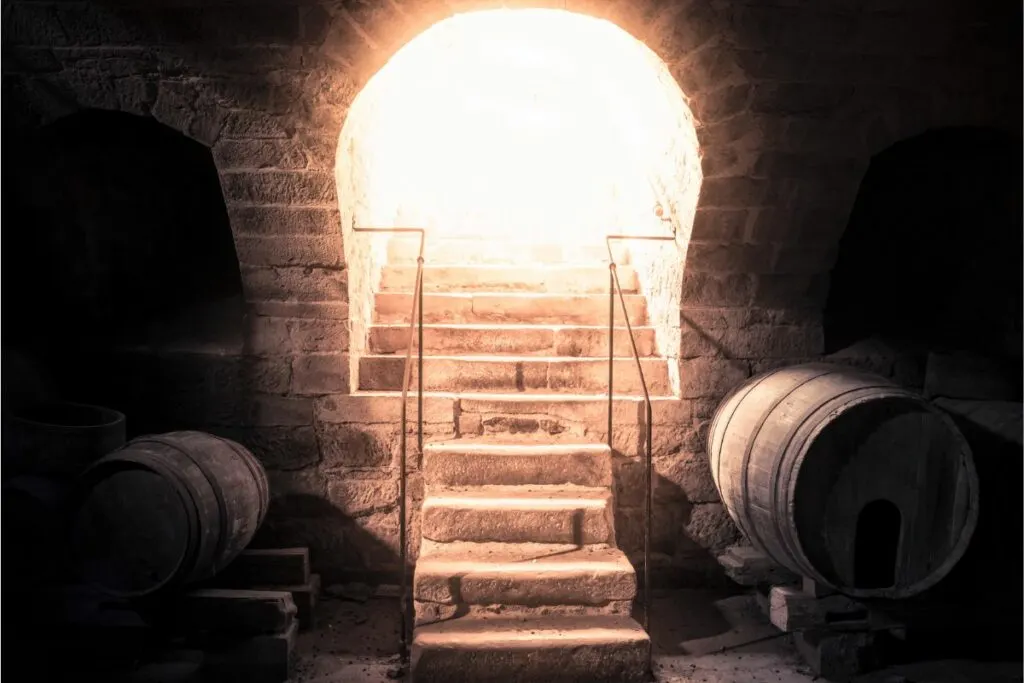
You’ve put in the time and effort to insulate, cool, and humidify your wine cellar, and you’ve invested in beautiful wood to support the weight of your collection. Do not cap this whole project off with any old door.
The door to your wine cellar needs to include all the same features as your front door. It should keep the climate on the inside regulated despite the conditions on the other side of the door. Like any good door, it should have a tight, weather-stripped seal all the way around, with an additionally well-sealed threshold.
The best part of this, though, is that front doors are fabulously beautiful and come in a wide variety of styles. While interior doors are fine, and you could probably find a nice one, shopping for a front door is so much more exciting.
Lastly, but still of note, using a nice front door to protect your wine investment allows you the ease of installing a secure locking mechanism.
This may seem nutty to some, but a lot of the wines housed behind this door are expensive and rare. So, go ahead and install a keypad entry, a double locking handle, or a ring door alarm if you want. No judgment here.
Don’t Forget to Accessorize
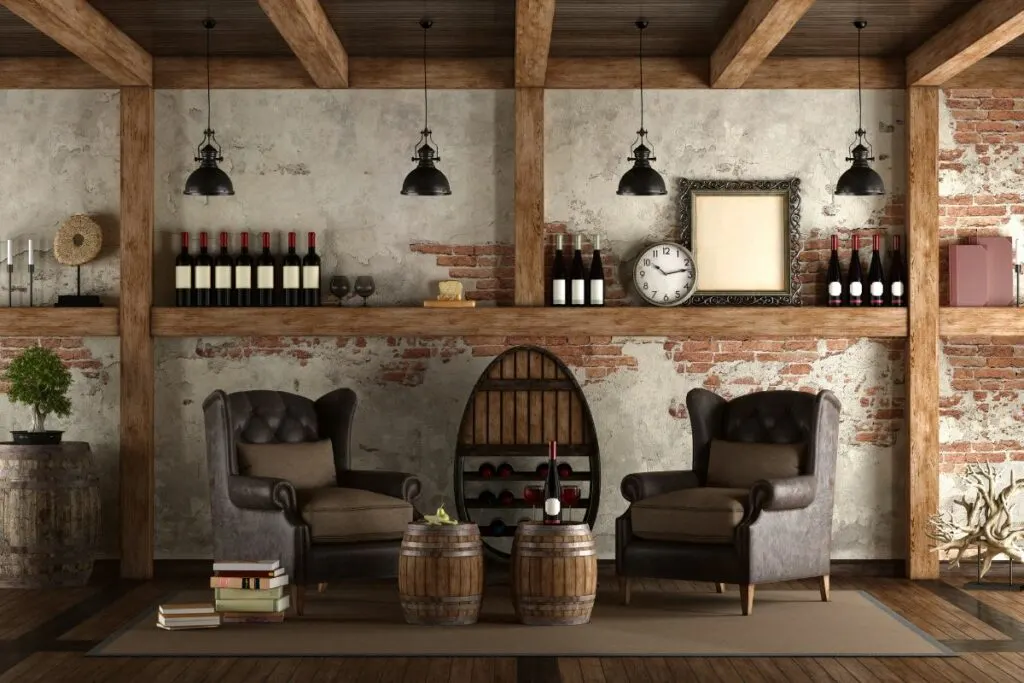
We are nearly finished, but we couldn’t leave without mentioning something that might be obvious. You’ll need some accessories for your wine cellar. Finishing touches that will make your wine feel right at home to include lighting fixtures, artwork, and maybe even seating.
Lighting
Good lighting will allow you to see the labels on your wine, but it can also create a mood.
- Lighting under the shelves will illuminate the bottles nicely. It also adds a museum quality look to it.
- A gorgeous chandelier can instantly upgrade your cellar to a palace or invoke the feeling of a remote cabin.
- Choose warmer light bulbs to establish a homey ambiance or use cooler lighting for a more modern feel.
Artwork
As for what artwork to include in your wine cellar, this is a matter of personal preference. However, little touches like wine infographics can help you and your guests make smart choices about which vintage to go with dinner. Art that serves an educational, as well as beautiful, is a modern choice.
Seating
We mentioned seating, and this may seem like an odd addition, but hear us out. Sometimes, you’re not going to want to go back upstairs to enjoy a glass or bottle of wine. Maybe you need a hiding spot, or maybe you want to enjoy this glorious new space with a friend.
Whatever the reason, making your wine cellar cozy for your wine as well as yourself is just good sense.
Recommendation box: Everything you need to enjoy your wine as much as possible. All recommended products are personally tested and regularly used by experts from this website (Amazon links):
> Ivation Wine Cooler – Energy-efficient wine cooler for 18 bottles with Wi-fi smart app control cooling system.
> Wine Rack – Beautiful, elegant wood rack for up to 7 bottles and the choice of vertical or horizontal storage.
> Durand Wine Opener – Classic vintage wine opener (we like all these classic staff).
> YouYah Iceberg Wine Decanter – The most beautiful and handy wine decanter we personally use.
> Bormioli Rocco Wine Glasses – A set of eight elegant and traditional wine glasses made in Italy.
> Vintorio Wine Aerator – Simple but really useful wine aerator for a reasonable price.
> The Original Vacu Vin Wine Saver – The best wine saver on the market in a package with two vacuum stoppers and two wine servers.
And if you want to become a true connoisseur of wine, we recommend reading the book Wine Folly: The Essential Guide to Wine (Amazon link), where you will find all the information you need about winemaking, wine varieties, flavors, and much more.
Putting a Cork in It
Now that you’ve worked through the type of wood you want your cellar built from, the kind of flooring that will support all your hard-won wine, and all the accouterments for keeping the climate ideal for your cherished bottles, you’re ready to sit back and relax.
Enjoy the spoils of your labor with a perfect glass of vino. The hardest choice you’ll have to make now is which bottle you want to open. Let’s face it, though, that’s going to be a tough decision. Good thing you have a beautiful cellar in which to ponder your choice.
TIP: Check out this page for a complete list of wine products and accessories I love. You’ll find my recommendations for wine refrigerators, decanters, and aerators and the best place to buy wine online. Click here to see the complete listing.
